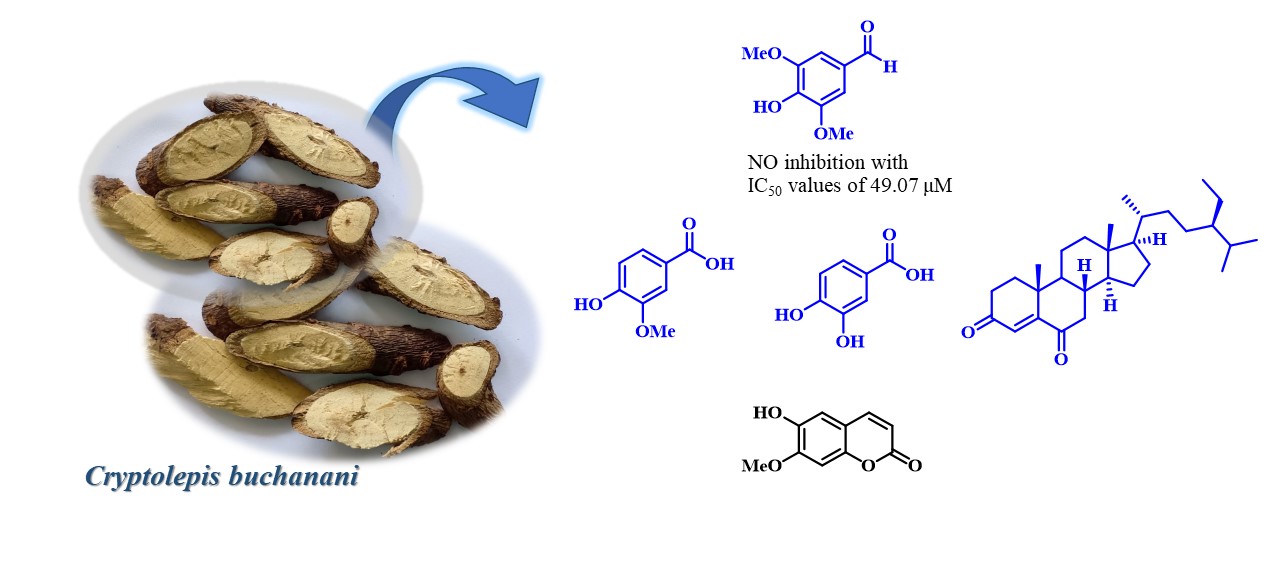Chemical Constituents and Their Anti-inflammatory Activities from the Stems of Cryptolepis buchanani
DOI:
https://doi.org/10.48048/tis.2023.6366Keywords:
Anti-inflammatory, Cryptolepis buchanani, Nitric oxide (NO), Thao En On, ChromatographyAbstract
The stems of Cryptolepis buchanani are traditionally used for the treatment of inflammation, including arthritis, muscle and joint pain. In the present study, 3 crude extracts (hexane, EtOAc and methanol) from the stems of C. buchanani were evaluated for anti-inflammatory effects using an in vitro model of RAW 264.7 macrophages. At a concentration of 50 μg/mL, the hexane and EtOAc crude extract have inhibited nitric oxide (NO) production by 84.33±2.01 and 82.49±0.92 %, respectively. 3,4-Dihydroxyl benzoic acid (1), vanillic acid (2), syringaldehyde (3), isoscopoletin (4) and stigmast-4-ene-3,6-dione (5) were isolated from hexane and EtOAc crude extracts. Their structures were identified on the basis of 1H and 13C NMR, as well as a comparison of the data from previous reports. Compounds 1-5 were evaluated for anti-inflammatory activity. Compound 3 showed activity of NO inhibition with IC50 values of 49.07 μM (Indomethacin IC50 values of 39.21 μM). In addition, compounds 1-3 and 5 were isolated for the first time from this plant.
HIGHLIGHTS
- The crude hexane and ethyl acetate (EtOAc) (each, 50 mg/mL) inhibited nitric oxide (NO) production with inhibition percentage at 84.33 and 82.49, respectively
- 3,4-Dihydroxyl benzoic acid, vanillic acid, syringaldehyde and stigmast-4-ene-3,6-dione were isolated for the first time from this plant
- Syringaldehyde showed activity of NO inhibition with IC50 values of 49.07 μM (Indomethacin IC50 values of 39.21 μM)
GRAPHICAL ABSTRACT
Downloads
Metrics
References
N Hanprasertpong, S Teekachunhatean, R Chaiwongsa, S Ongchai, P Kunanusorn, C Sangdee, A Panthong, S Bunteang, N Nathasaen and V Reutrakul. Analgesic, anti-inflammatory and chondroprotective activities of Cryptolepis buchanani extract: in vitro and in vivo studies. Biomed. Res. Int. 2014; 2014, 978582.
A Panthong, D Kanjanapothi and WC Taylor. Ethnobotanical review of medicinal plants from Thai traditional books. Part I. Plants with antiinflammatory, anti-asthmatic and antihypertensive properties. J. Ethnopharmacol. 1986; 18, 213-28.
P Laupattarakasem, T Wangsrimongkol, R Surarit and C Hahnvajanawong. In vitro and in vivo anti-inflammatory potential of Cryptolepis buchanani. J. Ethnopharmacol. 2006; 3, 349-54.
P Laupattarakasem, PJ Houghton, JRS Hoult and A Itharat. An evaluation of the activity related to inflammation of four plants used in Thailand to treat arthritis. J. Ethnopharmacol. 2003; 85, 207-15.
S Ramachandran, L Fadhil, C Gopi, M Amala and MD Dhanaraju. Evaluation of bone healing activity of Cissus quadrangularis (Linn), Cryptolepis buchanani, and Sardinella longiceps in Wistar rats. Beni-Suef Univ. J. Basic Appl. Sci. 2021; 10, 30.
R Venkateswara, N Narenda, MA Viswamitra and CS Vaidyanathan. Cryptosin a new cardenolide in tissue culture and intact plants of Cryptolepis buchanani Roem. & Schult. Plant Cell Rep. 1987; 6, 193-291.
BB Shah and MP Khare. Cryptolepis buchanani Roem.& Schult., a new source of sarmentogenin. J. Nepal Chem. Soc. 1981; 1, 103-7.
KK Purushothaman, S Vasanth, JD Comnolly and DS Rycroft. New sarverogenin and isosarverogenin in glycoside from Cryptolepis buchanani (Asclepiadaceae). Revista Latinoamericana de Química 1988; 19, 28-31.
JL Li, YL Zhao, XJ Qin, YP Liu and XD Luo. Chemical constituents from stems and leaves of Cryptolepis buchananii. Chin. Tradit. Herb. Drugs 2014; 45, 1677-81.
SK Dutta, BN Sharma, PV Sharma. Buchananine, a novel pyridine alkaloid from Cryptolepis buchanani. Phytochemistry 1978; 17, 2047-8.
SK Dutta, BN Sharma and PV Sharma. A new nicotinoyl glucoside from Cryptolepis buchanani. Phytochemistry 1980; 19, 1278.
S Tarasuntisuka, T Palagaa, H Kageyamac and RW Sirisatthaa. Mycosporine-2-glycine exerts anti-inflammatory and antioxidant effects in lipopolysaccharide (LPS)-stimulated RAW 264.7 macrophages. Arch. Biochem. Biophys. 2019; 662. 33-9
WT Rong, ZW De, SW Yun, Y Lu, TZ Qi and RY Chong. NMR assignments and single-crystal X-ray diffraction analysis of deoxyloganic acid. Magn. Reson. Chem. 2005; 43, 92-6.
JY Ban, SO Cho, SY Jeon, Bae KH, Song KS and Seong YH. 3,4-Dihydroxybenzoic acid from Smilacis chinae rhizome protects amyloid β protein (25–35)-induced neurotoxicity in cultured rat cortical neurons. Neurosci. Lett. 2007; 420, 184-8.
AC González-Baró, BS Parajón-Costa, CA Franca and R Pis-Diez. Theoretical and spectroscopic study of vanillic acid. J. Mol. Struct. 2008; 889, 204-10.
G Shi, M Xu, W Duan, L Fang, W Liu, X Wang and Y Zhang. Chemical constituents from Trichosanthis pericarp. Asian J. Chem. 2014; 26, 4626-30.
APD Pedroso, SC Santos, AA Steil, F Deschamps, A Barison, F Campos and MW Biavatti. Isolation of syringaldehyde from Mikania laevigata medicinal extract and its influence on the fatty acid profile of mice. Braz. J. Pharmacogn. 2008; 18, 63-9.
GR Ebede, JT Ndongo, JN Mbing, N Shehla, Au Rahman, DE Pegnyemb and MI Choudhary. Isolation of new secondary metabolites from the liana Landolphia lucida K. Schum. (Apocynaceae). Phytochem Lett. 2021; 41, 27-33.
DD Zhao, QS Zhao, L Liu, ZQ Chen, WM Zeng, H Lei and YL Zhang. Compounds from Dryopteris fragrans (L.) schott with cytotoxic activity. Molecules 2014; 19, 3345-55.
K Wei, W Li, K Koike, Y Pei, Y Chen and T Nikaido. Complete 1H and 13C NMR assignments of two phytosterols from roots of Piper nigrum. Magn. Reson. Chem. 2004; 42, 355-9.
K Padmalochana, MS Dhana Rajan, R Lalitha and H Sivasankari. Evaluation of the antioxidant and hepatoprotective activity of Cryptolepis Buchanani. J. Appl. Pharm. Sci. 2013; 3, 99-104.
A Kaul, S Bani, U Zutshi, KA Suri, NK Satti and OP Suri. Immunopotentiating properties of Cryptolepis buchanani root extract. Phytother. Res. 2003; 17, 1140-4.
S Shahzad, S Mateen, PM Mubeena Mariyath, SS Naeem, K Akhtar, W Rizvi and S Moin. Protective effect of syringaldehyde on biomolecular oxidation, inflammation and histopathological alterations in isoproterenol induced cardiotoxicity in rats. Biomed. Pharmacother. 2018; 108, 625-33.

Downloads
Published
How to Cite
Issue
Section
License
Copyright (c) 2022 Walailak University

This work is licensed under a Creative Commons Attribution-NonCommercial-NoDerivatives 4.0 International License.






